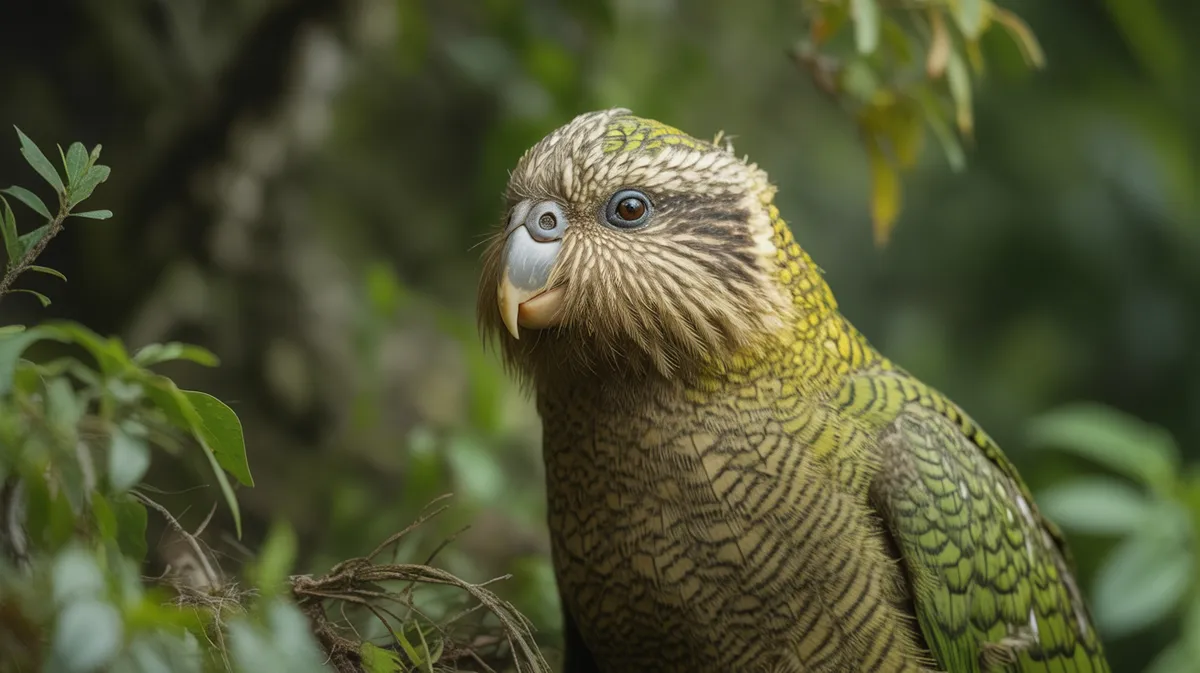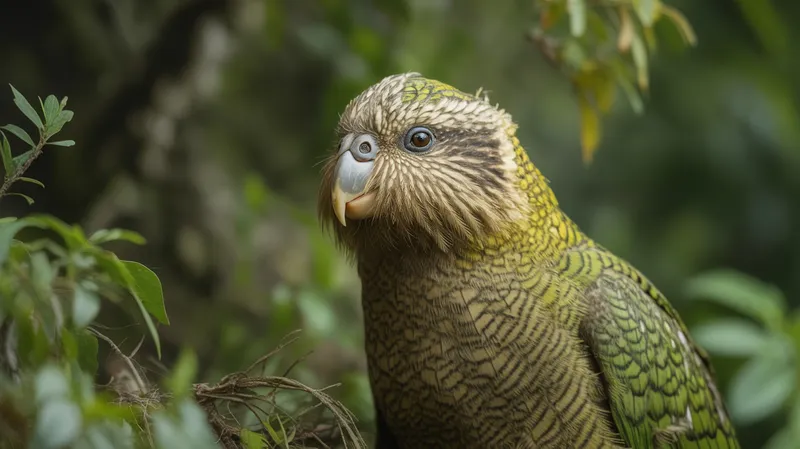
Kakapo
Strigops habroptilus

Meet the Kakapo
The kakapo, also known as the night parrot or owl parrot, is a large, nocturnal, flightless parrot native to New Zealand. It is distinguished by its moss-green, mottled plumage, owl-like facial disc, and robust, stocky build. The kakapo is the world’s only flightless parrot and the heaviest parrot species, using its wings for balance and support rather than flight. It is renowned for its unique booming courtship calls, which can be heard over great distances during breeding season. Due to predation and habitat loss, the kakapo is critically endangered, with only a small managed population remaining.
Classification
Bird
Habitat
Native temperate forests of New Zealand
Diet
Herbivore
Lifespan
40–60 years
Conservation
Critically Endangered
Weight
1.5–4 kg
📖Fascinating Facts
Flightless Parrot
The kakapo is the world’s only flightless parrot, using its wings for balance and support as it climbs trees and navigates the forest floor.
Nocturnal Lifestyle
Kakapos are nocturnal, foraging at night and remaining hidden during the day to avoid predators.
Booming Courtship
Male kakapos produce a distinctive, low-frequency booming call that can carry up to 5 kilometers to attract females during the breeding season.
📋Detailed Description
The kākāpō (Strigops habroptilus) is a large, nocturnal, flightless parrot endemic to New Zealand, and is the only member of its genus and family. Adults typically weigh between 1.5 and 4 kilograms, making it the heaviest parrot species in the world. Its robust body is covered in soft, moss-green feathers mottled with black and yellow, providing excellent camouflage in its native forest habitat. The kākāpō has a distinctive owl-like facial disc of fine feathers, aiding in sound localization, and large, forward-facing eyes adapted for night vision. Its wings are short and rounded, unsuitable for flight, but are used for balance and controlled descents from trees. The legs are strong and muscular, allowing the bird to climb trees and cover considerable distances on foot. Kākāpō are solitary and primarily nocturnal, spending daylight hours resting in cover. Their vocalizations are unique, especially the deep, resonant 'booming' calls produced by males during the breeding season, which can travel several kilometers. The species is long-lived, with some individuals known to exceed 60 years of age in managed care.
💡 Did you know?
Kakapos store large amounts of energy as fat, making them the world’s heaviest parrot species.
🔬Research & Sources
Wikipedia Summary
The kākāpō, sometimes known as the owl parrot or owl-faced parrot, is a species of large, nocturnal, ground-dwelling parrot of the superfamily Strigopoidea. It is endemic to New Zealand.
Last Modified: 5/23/2025
🎭Behavior & Social Structure
Kākāpō are primarily solitary outside the breeding season, with individuals maintaining overlapping home ranges. They are nocturnal, emerging at dusk to forage on the forest floor and occasionally in low vegetation. Their diet consists mainly of native plant material, including leaves, seeds, fruits, bark, and rhizomes, with a particular preference for rimu fruit during breeding years. Kākāpō use their powerful beaks to strip bark and crush tough plant fibers, and their digestive system is adapted to extract nutrients from fibrous material. Locomotion is predominantly by walking or running, but they are adept climbers, using their beak and claws to ascend trees. Social interactions are limited, but males may congregate at traditional 'leks' during the breeding season, where they compete acoustically for female attention. Daily routines involve alternating periods of rest in well-concealed daytime roosts and active foraging at night.
👶Reproduction & Life Cycle
Kākāpō exhibit a lek breeding system, one of the few parrots to do so. Males establish display arenas, or 'track and bowl' systems, where they clear ground and create shallow depressions to amplify their booming calls. The breeding season is irregular, typically occurring every 2–4 years and closely linked to the mast fruiting of rimu trees (Dacrydium cupressinum). Males call for several weeks to attract females, who visit multiple leks before selecting a mate. After mating, females lay 1–4 eggs in well-hidden nests on the ground, often under dense vegetation or in hollow logs. Incubation lasts about 30 days, and only the female provides parental care, leaving the nest at night to feed. Chicks fledge at around 10–12 weeks but remain dependent on the mother for several more weeks. The species' slow reproductive rate and irregular breeding cycles contribute to its vulnerability.
🛡️Adaptations & Survival
The kākāpō has evolved several unique adaptations for its ground-dwelling, nocturnal lifestyle. Its cryptic plumage provides camouflage from predators, while its facial disc enhances auditory perception in low light. The lack of flight is compensated by strong legs for terrestrial locomotion and tree climbing. Kākāpō have a keen sense of smell, unusual among birds, which aids in foraging and navigation. Their digestive tract is specialized for processing fibrous plant material, and their ability to store fat allows them to survive periods of food scarcity. The lek mating system and reliance on mast fruiting events are rare among parrots and reflect adaptation to New Zealand's unpredictable environment.
🎨Cultural Significance
The kākāpō holds significant cultural value for Māori, who traditionally regarded it as a taonga (treasure). Its feathers were used for cloaks (kākahu) and ceremonial purposes, and the bird features in Māori oral traditions and legends. The kākāpō's plight has made it a symbol of New Zealand's unique biodiversity and the challenges of conservation in island ecosystems. It is a flagship species for conservation awareness and has gained international attention through media and public engagement campaigns, including the famous ambassador bird, Sirocco.
🔬Recent Research & Discoveries
Recent research has focused on the kākāpō's genetics to manage inbreeding and maximize genetic diversity within the small population. Advances in reproductive technology, such as artificial insemination and genome sequencing, have improved breeding success. Studies on vocal communication have revealed the acoustic properties of booming and chinging calls and their role in mate selection. Ongoing ecological research monitors diet, health, and disease susceptibility, including the management of aspergillosis outbreaks in 2019–2020. Conservation science continues to refine techniques for hand-rearing, supplementary feeding, and habitat restoration to support population growth.
🎥Wildlife Videos

The Strangest Parrot in the World | Modern Dinosaurs
The kakapo is a very rare, plump parrot that lives in New Zealand. It's inability to fly and that it's nocturnal make it the strangest ...
Discovery UK

"Kakapo Parrot: The Rare Nocturnal Wonder of New Zealand | Wildlife Documentary"
Step into the enchanting world of the Kakapo Parrot, the rare flightless nocturnal wonder of New Zealand! This fascinating bird ...
Nature world

Top 10 Rarest Birds Found Only in One Country – You Won’t Believe #3!
Discover 10 of the world's most extraordinary birds—each found in just one country! From the flightless Kakapo of New Zealand to ...
Binzo Life

Kakapo the World's Heaviest Parrot
The KAKAPO, a nocturnal parrot native to New Zealand, is a fascinating creature with many unique traits. For a deeper insight into ...
Nature's Flex

Meet the Locals: Saving the kākāpō
Season 4, episode 19: Learn about how DOC have brought the kākāpō back from the brink of extinction. Nic talks to Don Merton ...
Department of Conservation

DOCUMENTAIRE KAKAPO
Martin Dziura-Keukelinck
🌍Habitat Information
The Kakapo typically inhabits Native temperate forests of New Zealand environments. Kakapos have adapted to their environments with specialized features and behaviors.
Primary Habitat:
Native temperate forests of New Zealand
More detailed habitat information will be available soon.
🛡️Conservation Status
The Kakapo is currently classified as Critically Endangered. Conservation efforts are crucial for preserving this species for future generations.
Common Threats:
- 🏠Habitat loss and fragmentation
- 🌡️Climate change impacts
- 🎯Hunting and poaching
- 🏭Human-wildlife conflict
⚠️Threats & Conservation Challenges
The kākāpō faces critical threats from introduced mammalian predators such as stoats, rats, and cats, which prey on eggs, chicks, and adults. Habitat loss due to deforestation and land conversion has severely reduced its range. The species' low reproductive rate, inbreeding depression, and dependence on irregular food resources further hinder recovery. Intensive conservation management, including translocation to predator-free islands, hand-rearing of chicks, genetic monitoring, and artificial insemination, has been essential to prevent extinction. As of 2024, the managed population numbers just over 250 individuals, with all known birds individually named and monitored. Climate change and disease remain emerging threats to long-term survival.
🔬Scientific Classification
Scientific Name
Strigops habroptilus
Classification Hierarchy
🔍 About Taxonomic Classification
Taxonomic classification is a hierarchical system used by scientists to classify and organize living organisms based on shared characteristics and evolutionary relationships.
The system moves from broad categories (Kingdom) to increasingly specific ones, with each animal's scientific name typically consisting of its Genus and species.
📝Community Notes
Share your observations and insights about the Kakapo with our community of wildlife enthusiasts.
Join Our Community
Sign in to share your observations and connect with fellow wildlife enthusiasts.
Sign In to ContributeNo community notes yet
Be the first to share your observations about the Kakapo!
Explore Kakapo
Select a tab above to learn more about this amazing animal.
📸Photo Gallery
No photos available for this animal yet.
🌟Discover More Wildlife
Continue your journey of discovery with more fascinating animals from our database
